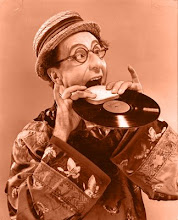Clutch Cargo and the Magic of Synchro-Vox

Brentwood Home Video, makers of many fine dollar DVDs and shameless purveyors of obscure media, have released the entire run of Clark Haas' mindbending 1959 kidvid magnum opus Clutch Cargo to DVD. At $30 for the complete two volume set (cheaper at Amazon), the price is certainly right.
For the uninitiated, Clutch Cargo was a cartoon adventure serial running five days a week as a segment on hundreds of locally-hosted kid's cartoon shows in the late 50s and early 60s. The show's concept was basic in the extreme; international adventurer Clutch Cargo (action), travels around the world with his young ward Spinner (audience identification) and his dog Paddlefoot (comic relief). The stories are simple and embody a certain period charm (like tiki glasses, avocado green, or the decor of a Bob's Big Boy), and creator Clark Haas' fondness for puns and non-sequitur gags frequently shows through. As is to expected from a TV show of this vintage, there are plenty of stereotypes, ethnic and otherwise, to be found. Virtually every villain in the show is fat and swarthy.
Clutch Cargo was promoted by its production house, Cambria Studio, as a "TV comic strip" for a reason. It's not exactly animated. If anything, the series was a clever exercise on the part of Cambria Studio to avoid limited, let alone full, animation (although there are rare flashes of both to be found). It's actually pseudo-mation. An array of techniques were used to create the illusion of movement without going through the trouble and expense of shooting anything frame-by-frame, most resembling a kind of 2-D puppetry. For instance, to simulate Clutch and co. walking, a cel featuring the characters' torsos in profile was bobbed up and down by hand across the camera's field of vision. Real flames and smoke were superimposed when needed. In once instance, a red balloon was used to simulate bubble gum emerging from a jet plane's engine (it's a very silly show). But best of all, and the primary reason for Clutch Cargo's notoriety, was Cambria's biggest animation-saver: Synchro-Vox. As dialogue, rather than movement, had to carry much of the weight of the series' stories, Cambria was still faced with the prospect of having to create limited animation every time a character spoke. But thanks to the miracle of Synchro-Vox, Cambria was spared the cost; the voice actors' mouths were simply superimposed onto the characters' faces. The Synchro-Vox technique is pretty bizarre at first glance, but, for me at least, after a few episodes it simply becomes a part of the show's language. Admittedly, however, there is something decidedly disconcerting about Margaret Kerry's very feminine mouth superimposed on Spinner's face, especially as she doesn't do a very convincing boy's voice in the first place (Kerry was, incidentally, the live-action model for Tinkerbell in Disney's Peter Pan). The characters were designed to allow plenty of room for the live-action mouths, so there are lots of huge chins, wide faces, and large beards to be seen.

I found this nice example of Clark Haas' original art on Ebay. Perhaps this is one of the concept drawings he used to sell Clutch Cargo to Cambria Studio Inc. in 1958. The character designs are very different than those eventually used in the series. This drawing is also very much in the style Haas used when he took over the comic strip Buzz Sawyer from the great Roy Crane.
Cambria's emphasis on voice work, stories, and design rather than animation surprisingly works in the series' favor, a good example of innovation turning a weakness into a strength. In the case of Clutch Cargo, the near complete absence of animation allowed the series' artists to concentrate on making attractive individual drawings and layouts, so the show actually looks better than most limited animation series of the same vintage and, IMO, more watchable. It's a case of no animation at all being better than crummy animation, a philosophy Cambria should have stuck with when they later produced the horrible New Three Stooges cartoons of 1965-1966 (and which would have put Hanna-Barbera and Filmation completely out of business in the 1970s).

This advantages of Synchro-Vox and pseudo-mation are further displayed by one of the DVD extras on volume one; a complete five-episode story arc of another Synchro-Vox series, Space Angel (1962-64). Far less cartoon-y and technically superior to Clutch Cargo, Space Angel was designed by none other than DC cartoonist Alex Toth. The live-action mouths are less intrusive and better integrated into the character designs, and Toth's artwork makes the show strikingly attractive.. certainly more attractive than his later work on Space Ghost for Hanna-Barbera. Volume two features an episode of the third and last Synchro-Vox series, Captain Fathom, an even talkier, somewhat more sophisticated show (plot-wise) that has the overall feel of a Garry Anderson Supermarionation series. I noticed former Screen Gems director/animator Chic Otterstrom's name among the credits for the art crew at the end, along with Clark Haas who did double duty as the series' supervising director and clearly wasn't above getting his hands dirty as a pseudomator.





1 Comments:
As I understand it, Clark Haas started out doing a version of Synchro-Vox on live action shorts in the forties: putting human mouths to animals, for instance. There's a Haas-created music video from the wing era for Freddie Mack's "Cow Cow Boogie" that features the song being sung by a herd of ambling cows, for instance. (It used to regularly run on the old Comedy Channel - which also showed "Clutch Cargo," incidentally.)
For me, the most memorable aspect of "Clutch" remains its jaunty li'l "exotic" theme song - which lingers with me to this day. . .
Post a Comment
<< Home